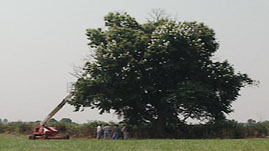Teachers' Domain - Digital Media for the Classroom and Professional Development
User: Preview

Source: KET's Electronic Field Trip to the Forest
See the devastating impact of blight on the American chestnut tree in this annotated slideshow adapted from KET's Electronic Field Trip to the Forest. Learn the scientific processes scientists use to identify the remaining trees, document their locations, and cross-pollinate them with other varieties of chestnut trees to create hybrids that are blight-resistant.
The American chestnut tree was once the most common tree in forests of the eastern United States. Growing straight and tall, bearing edible, tasty nuts, and producing strong yet lightweight lumber that resists decay, the American chestnut tree seemed the ideal species. It was ideal in every respect but one…
In the early twentieth century, Japanese chestnut trees were imported to the United States for exotic, ornamental gardens, bringing with them the fungus Cryphonectria parasitica. Chestnut tree species in Asia evolved alongside the fungus and developed varying degrees of resistance to it, but, separated by an ocean and a continent, the American chestnut species did not.
When an American chestnut tree’s bark is infected by pathogens, the tree responds by growing a canker around the interloper, preventing the spread of disease to the rest of the tree. The canker also stops movement of nutrients through the cambium, or live part of the tree, at that location, but the damage is relatively minor. When C. parasitica infects an American chestnut tree, the fungus grows faster than the canker, so the canker never completely surrounds the fungus, which keeps growing until it completes a circle around the infected limb or trunk. Everything above the canker, except the fungus, dies. With spores easily carried by insects, birds and wind to other trees, C. parasitica quickly spread through American chestnut forests in the early 1900s, killing billions of trees and dramatically altering the appearance and function of forest ecosystems. The effects were so disastrous that this chestnut canker disease became known as the chestnut blight.
The news is not all bad, though. Most American chestnut trees only die above the canker, and the surviving root collars grow sprouts that could become mature trees. Battered by insects, deer, and other normal factors, a gradually decreasing number of infected chestnut trees still continue the cycle of sprout, growth, infection, upper tree death, and re-sprout. While the tree sprouts look more like shrubs than trees and rarely mature enough for sexual reproduction, for a while this cyclic process preserves some of the genetic biodiversity within the species.
The best news is that a few mature American chestnut trees actually survived the blight, and their genetic material is being used by researchers who hope to produce both genetically modified, blight-resistant transgenic American chestnut trees and blight resistant American-Chinese hybrids. Perhaps majestic chestnut trees will once again be an important component of the eastern deciduous woodland, filling a large void created by imported, invasive pests that kill not only chestnut, but also pine, hemlock, elm, and many other trees in the ever shifting landscape of forest ecology.
To learn more about the restoration efforts for this species of tree, check out Restoration of the American Chestnut.
 Loading Standards
Loading Standards